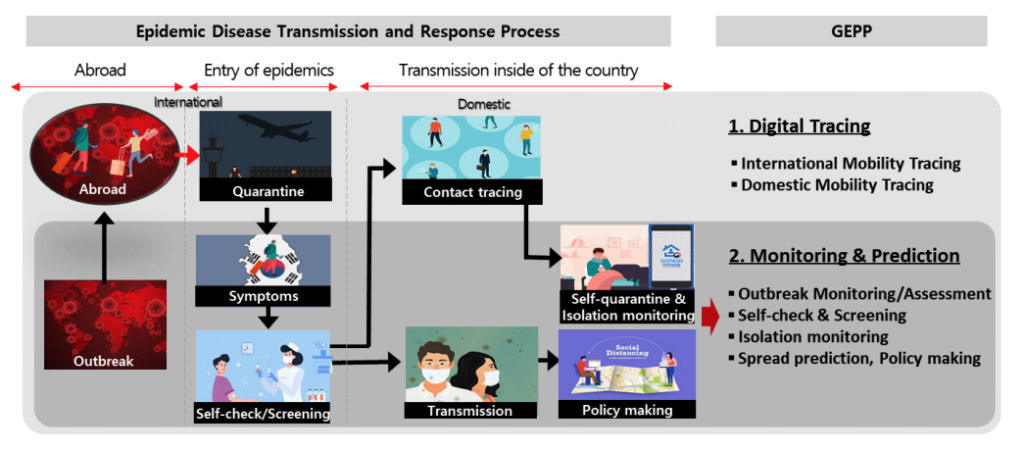Following this positive outcome, the world has been paying attention to Korea’s case and the government has summarized the key factors of successful response as 3T (test-trace-treat) system on the basis of ICT. Among the 3Ts, tracing is the most pivotal given it helps early detection to prevent additional spread. Additionally, the Global Epidemic Prevention Platform (GEPP) is assisting the national effort to contain COVID-19 with Digital Tracing.
Background
The new pandemic, COVID-19 has been spreading all around the world, causing a huge impact on economic and social crisis. While the world is still fighting against the COVID-19 over the past few months, South Korea has been touted as one of the most successful countries in responding to COVID-19. According to the document “Flattening the curve on COVID-19,” which was published by the government, Korean authority has been rapidly responding to the outbreak of COVID-19 in Korea and successfully flattened the curve on COVID-19 in 20 days.

Following this positive outcome, the world has been paying attention to Korea’s case and the government has summarized the key factors of successful response as 3T (test-trace-treat) system on the basis of ICT. Among the 3Ts, tracing is the most pivotal given it helps early detection to prevent additional spread. Global Epidemic Prevention Platform (GEPP) is assisting the national effort to contain COVID-19 with Digital Tracing.
What is Digital Tracing?
Digital Tracing helps to prevent the spread of infectious disease by identifying the pathway of confirmed cases using mobile roaming technology. Digital tracing is classified into two models: one is International Mobility Tracing and the other is Domestic Mobility Tracing.
In 2015 MERS-CoV broke out in South Korea. In 2016 as part of preparation, Korea Center for Disease Control adopted GEPP to assist the national surveillance, starting with International Mobility Tracing.
International Mobility Tracing
International Mobility Tracing serves to prevent overseas infectious disease by identifying citizens traveling to epidemic-prone countries before returning home country and notifying the information to KCDC for quarantine, if necessary.
Main features of International Mobility Tracing is as follows:
- Government can identify the pathway of those who are traveling to epidemic-prone countries by tracing their roaming records.
- Traveler receive SMS alerts on disease information of the country and preventive measures when travel and return.
- Using monitoring dashboard, government collects relevant statistical data for policy decisions, including global outbreak and citizens’ entry status from disease-prone countries. (The data is visualized on the dashboard real time.)
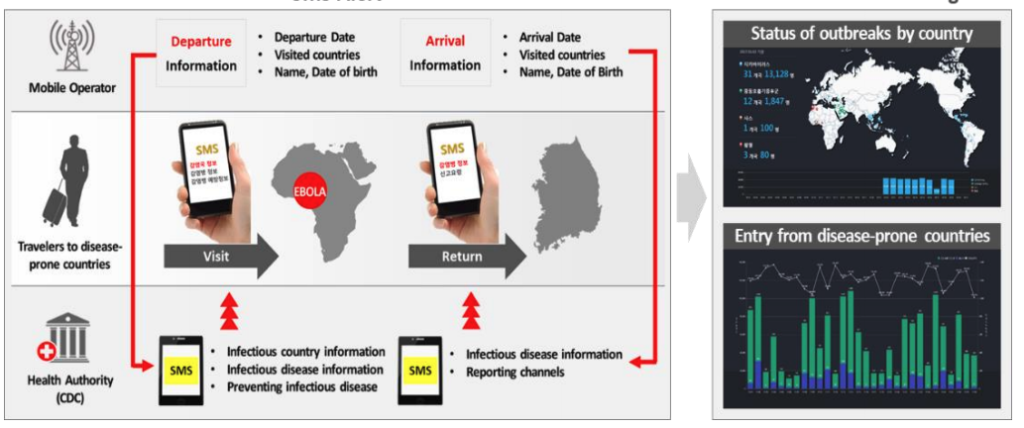
Domestic Mobility Tracing
When an outbreak occurs inside of the country, Domestic Mobility Tracing helps the government to quarantine timely by identifying a travel history of the confirmed cases. There are two sorts of tracing; Tracing of Confirmed Cases and Contact Tracing.
- Tracing of Confirmed Cases find outs a pathway of confirmed cases by checking out the history of their mobile locations having recorded by aligned mobile base station. (A variety of positioning technologies can be used for mobility tracing, such as GPS. South Korea is highly dense with skyscrapers, therefore cellular positioning is more accurate than GPS.)
- Contact Tracing can find out suspects who presented on the same pathway and stayed near the infected. (This function gives the number of mobile users in proximity and contact duration)
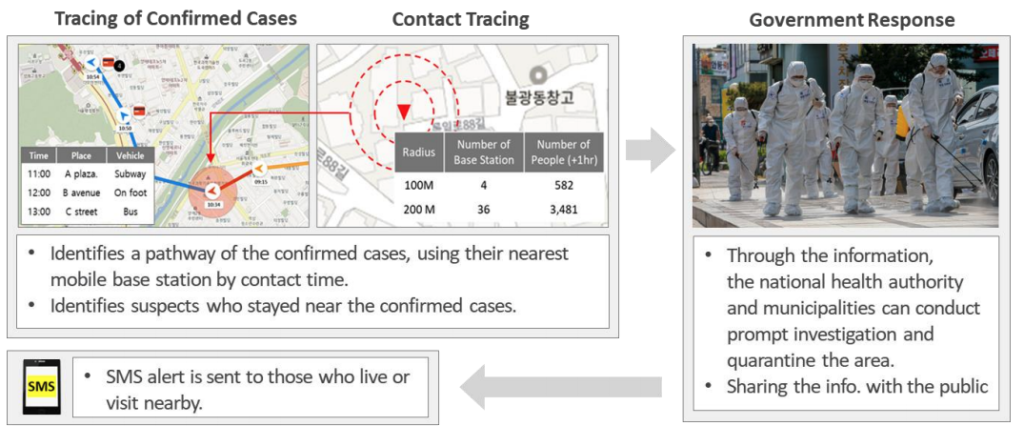
Contact tracing is highly effective when there is an epidemic hotspot that government needs to rapidly investigate. Government can make an immediate announcement and polices for quarantine.
In efforts to search a privacy preserving technology while containing COVID-19, contact tracing app using GPS has gained high attention in Europe. However GPS is inaccurate in highly dense cities, being misused (e.g ‘Fake GPS App’), requiring voluntary downloads, and often technically malfunctioning in comparison with using mobile location data. Therefore, Korean Government is using public and personal location data for emergency as per the act, Infectious Disease Prevention and Management Act Article 76 Paragraph 2. Within the law framework, KCDC manages to make the most of the telecommunications data for quarantine purposes.
Outcome
Since its inception in 2016, GEPP has been making a case for effect of the improvement of national surveillance and early containment at the several outbreaks in the past and today.
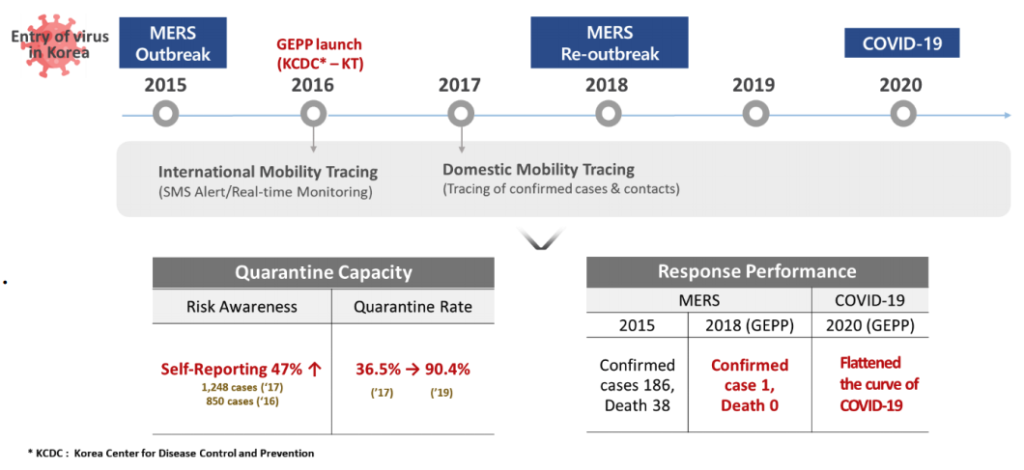
Improvement in national surveillance capacity
The national surveillance capacity improved in two ways: one was to improve risk awareness of citizens who are exposed to infection risk, helping citizen’s early reporting to the government and taking own precautions, and the other was to improve authority’s capability of detecting the entry of citizens from epidemic prone countries. The improvement is pronounced in figures. In 2017, 47% of citizens who had traveled to epidemic prone countries are more opt to do a self-reporting on their risk to the government. In addition, the government could identify almost by 90% of citizens who returned from epidemic-prone countries in 2019 compared to that of 2017.
Improvement in early containment of infectious disease
After the first outbreak in 2015, MERS-CoV broke out again in 2018 but the Korean government swiftly contained it without an additional case thanks to the early reporting of the first confirmed person and timely contact tracing followed by. (In 2015 the first MERCoV outbreak resulted in killing 38 and 186 confirmed cases). This year COVID-19 broke out, and the government has well managed to flatten the COVID19 curve through the consolidated response policy on the basis of diverse data from digital tracing, including close contacts. GEPP’s Digital Tracing is duly supporting the government to conduct fast response to terminate COVID-19.
Contribution to mitigating economic loss
Contact tracing helps to mitigate economic loss that can be caused by pandemics because it doesn’t require city lock downs. According to the research of the American National Bureau of Economic Research contact tracing helps to reduce economic loss by allowing economic activities in the city. The 2015 first MERS-CoV in Korea slashed the annual economic growth by 0.3% point , and Korean government didn’t consider lock downs from the beginning of the COVID-19 outbreak. `Contact tracing is helping the Korean economy to be more sustainable despite the pandemic situation.
A Way Forward with GEPP: Comprehensive Mobile Infectious Disease Reponse System
Role of mobile ICT in the NPIs(Non Pharmaceutical Interventions)
The world worries over possibilities of future outbreaks after Covid-19. Efficient test and treatment is crucial to reduce spread and swiftly terminate virus. Nevertheless, medical resources such as test kits are not always available, and developing vaccines takes long time. Therefore, prevention through NPIs(Non Pharmaceutical Interventions) including washing hands, wearing masks, and social distancing is crucial. And Mobile ICT solutions can assist the NPIs and also help the stages of national response framework from surveillance, detection, tracing, and up to prediction.
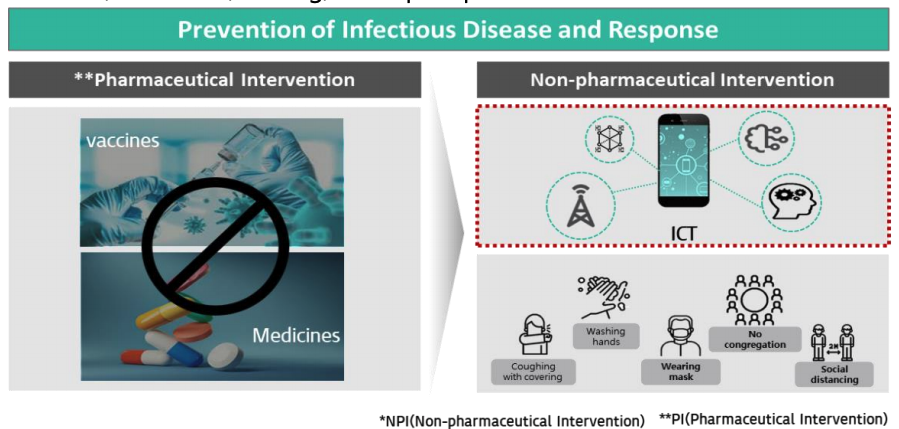
GEPP's Vision
In this regard, GEPP is working to become a global model of comprehensive mobile response system that assists a national framework of the countries. This work includes advancing a prediction area at the back-end, using AI and bigdata to align with a national framework. KT trusts that such a comprehensive mobile response system can contribute to the world to prepare for future pandemics to save people’s life and dignity.
